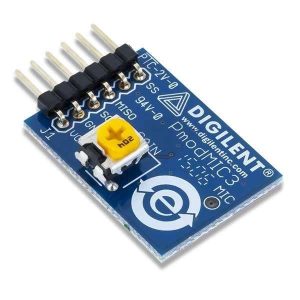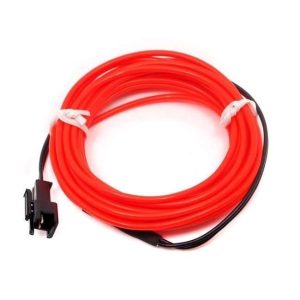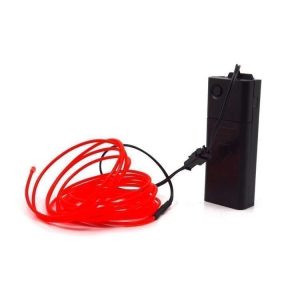There’s a new LED strip in town! These fancy new LED strips are a great upgrade for people who have loved and used strips for a few years but want something even better. The flexible, waterproof strip runs on 5 V and can be chained with additional APA102C strips to form longer runs or cut apart between each LED for shorter sections. The LEDs use generic 2-wire SPI, so you can push data much faster than with the Pixel 800 KHz protocol and there’s no specific timing required. They also have much higher PWM refresh rates, so you can do Persistence-of-Vision (POV) and have less flickering, particularly at low brightness levels.
These LEDs are 5050-sized LEDs with an embedded microcontroller inside the LED. You can set the color/brightness of each LED to 24-bit color (8 bits each red green and blue). Each LED acts like a shift register, reading incoming color data on the input pins, and then shifting the previous color data out on the output pin. By sending a long string of data, you can control an infinite number of LEDs, just tack on more or cut off unwanted LEDs at the end. The PWM is built into each LED-chip so once you set the color you can stop talking to the strip and it will continue to PWM all the LEDs for you
These LEDs have 2 wires (input and output) for sending data – one clock pin and one data pin. That means you need two pins, not one, to control DotStars. Because the clock and data is separated, you can use any processor speed or type to control these strips, and you don’t have to worry about being careful with the timing. Hardware SPI support is handy but not required. This makes them excellent for use with any microcontroller or microprocessor, including Arduino, Raspberry Pi, BeagleBone, Propeller, SparkCore, and any ‘raw’ microcontrollers/microprocessors. It’s very easy to port the library, and you can send data to the pixels at up to 32MHz clock rate!
Another nice thing about DotStars is their high PWM rate. You only have to set the 24-bit color data for each pixel LED once, and then the LED+built-in-chip will handle the PWMing of the red, green and blue. On NeoPixels, this PWM rate happens 400 Hz, which works well but is noticably at lower brightnesses and if the strip is moving in any way. DotStars have a 20 KHz PWM rate, so even when moving the strip around, you won’t see the pixelation, the color blending is very smooth.
This is the 60 LED-per-meter version of our DotStar strips, on black flex PCB. The strip is made of flexible PCB material, and comes with a weatherproof sheathing. You can cut this stuff pretty easily with wire cutters, there are cut-lines every 0.65″/1.7cm (1 LED each). Solder to the 0.1″ copper pads and you’re good to go. Of course, you can also connect strips together to make them longer, just watch how much current you need! You must use a 5V DC power supply to power these strips, do not use higher than 6V or you can destroy the entire strip
To wire up these strips we suggest picking up some JST SM plug and receptacle cables for the signal wires For the power wires, you will also probably want a 2.1mm DC jack to wire in so you can connect one of our 5V wall adapters to power it.
You can also refer to the following link: HERE
TECHNICAL DETAILS

The manufacturer of the APA102C smart LED used in this strip can be GRB order or BRG color order. This means if you are using our DotStar library, you’ll need to change the initialization to tell it which you are using. Check the tutorial for details on how to do this! The LED colors are otherwise identical, you just have to pipe the data to it in a slightly different order.
Technical specs (for the strips):
-
Width (with weatherstripping): 14mm / 0.55″
-
Thickness (with weatherstripping): 4mm / 0.16″
-
60 LEDs per meter
-
Pixel pitch: 16.65mm / 0.65″ between LEDs
-
Operating temperature: -40°C – 40°C
-
Storage temperature: -10°C – 50°C
Technical specs (for the LEDs):
-
Light source: Epistar 5050 SMD LEDs
-
LED Brightness: Red ~600mcd, Green ~500mcd, Blue ~150mcd
-
Beam angle: ~160°
-
Max current draw per RGB LED: ~60mA (20mA max per Red, Green & Blue LED)
Note: Strips come with 4 solder points per segment, but the arrangement may vary depending on the supplier, so please check when soldering/powering!
File downloads
Recommended links
- APA102 library for Arduino
- This library allows you to control an arbitrary number of APA102-Based Addressable RGB LEDs from an Arduino.
- Adafruit DotStar library for Arduino
- This Arduino library from Adafruit is an alternative to our library and should work for controlling our APA102-Based Addressable RGB LEDs.
- Adafruit DotStar Python module for Raspberry Pi
- This Python module from Adafruit can be used to control our APA102-Based Addressable RGB LEDs from a Raspberry Pi.
- FastLED library for Arduino
- FastLED is an Arduino library for controlling addressable LEDs that focuses on performance and offers advanced functionality like color correction. It supports our APA102-Based Addressable RGB LEDs and SK6812/WS281x-Based Addressable RGB LEDs.
- Understanding the APA102 “Superled”
- This blog article analyzes the SPI protocol of the APA102 and provides a library for controlling APA102-based LEDs with 8-bit AVR microcontrollers.










